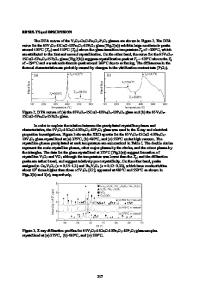Effects of V 2 O 5 on the synthesis of Ba 2 Ti 9 O 20 powders
- PDF / 641,673 Bytes
- 4 Pages / 612 x 792 pts (letter) Page_size
- 9 Downloads / 330 Views
Phase-pure Ba2Ti9O20 powders were made by doping 3 wt% of V2O5 to a Ba:Ti ⳱ 2:9 molar composition, and the effects of the dopant on the phase formation were investigated. The study shows that BaTiO3, BaTi2O5, and BaTi4O9 were the intermediate phases before the formation of Ba2Ti9O20 for samples with or without V2O5. However, with V2O5 doping, the temperature at which Ba2Ti9O20 occurred were lowered from 1150 to 1050 °C and single phase Ba2Ti9O20 powders was easily obtained at 1150 °C for 2 h. Microstructure of the powders was examined by field emission scanning electron microscopy. No evidence of V2O5–Ba2Ti9O20 solid-solution was found by x-ray diffraction and energy-dispersive spectroscopy. The benefit of V2O5 to facilitate the Ba2Ti9O20 synthesis is most probably due to a vanadium-containing eutectic liquid phase which accelerates the migration of reactant species.
I. INTRODUCTION
As a microwave dielectric material, Ba2Ti9O20 ceramic has received great attention for its good dielectric properties, such as high-dielectric constant (⑀r ⳱ 39.8), low-dielectric loss (Q ⳱ 8000 at 4 GHz) and low temperature coefficient (f ⳱ 2 ppm/°C).1,2 However, monophase Ba2Ti9O20 is not easy to synthesize. There are many other TiO2-rich compounds in the BaO–TiO2 system, like Ba6Ti17O40, BaTi3O7, BaTi4O9, BaTi5O11, Ba4Ti13O30,3,4 etc., which are formed more easily than Ba2Ti9O20. Furthermore, studies have revealed a curvature in the Ba2Ti9O20 equilibrium phase boundary in the BaO–TiO2 system at high temperature, which creates an additional complication in forming monophase Ba2Ti9O20.4 Jaakola et al.5 noted that a reaction temperature of 1150 °C or higher is necessary for the crystallization of Ba2Ti9O20 within a reasonable time span in a mixture of BaCO3 and TiO2. Wu and Wang gave a phase development sequence of BaTi5O11 → BaTi4O9 → Ba2Ti9O20 and proposed that in addition to diffusion, the nucleation barrier is another important factor in the formation of Ba 2 Ti 9 O 20 . 6 The low formation rate of Ba2Ti9O20 has been attributed to the increase in distance between intermediate phases,7–9 high surface and interface energies,6 or the high potential energy barrier arising from the crystal structure.10
a)
Address all correspondence to this author. e-mail: [email protected] DOI: 10.1557/JMR.2005.0333 J. Mater. Res., Vol. 20, No. 10, Oct 2005
http://journals.cambridge.org
Downloaded: 06 Dec 2014
There are several additives that can improve the formation of Ba2Ti9O20 phase, such as SnO2, ZrO2,11 SrO,12 Al2O3, or Bi2O3,10 and B2O3.13 Negas et al. reported that single-phase Ba2Ti9O20 could be synthesized without doping near 1300 °C but decomposed at temperatures above 1300 °C.14 Past studies have shown that the addition of V2O5 on commercial microwave materials has the advantages of lowering sintering temperatures and improving the dielectric properties. However, the effects of V2O5 on the synthesis of Ba2Ti9O20 have not been reported. In this study, the effect of V2O5 on the phase formation of Ba2Ti9O20 was investigated. The sint
Data Loading...











